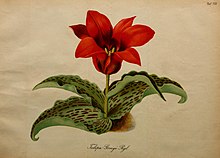bio.wikisort.org - Plant
Tulipa greigii, (Greig's tulip) is a species of tulip native to Central Asia and Iran.[2]
| Tulipa greigii | |
|---|---|
 | |
| Tulipa greigii botanical illustration | |
| Scientific classification | |
| Kingdom: | Plantae |
| Clade: | Tracheophytes |
| Clade: | Angiosperms |
| Clade: | Monocots |
| Order: | Liliales |
| Family: | Liliaceae |
| Subfamily: | Lilioideae |
| Tribe: | Lilieae |
| Genus: | Tulipa |
| Species: | T. greigii |
| Binomial name | |
| Tulipa greigii Regel[1] | |
| Synonyms[2][3] | |
|
List
| |
Taxonomy
The Latin specific epithet greigi honors the Russian Samuel Greig,[4] (1735-1788, "Father of the Russian navy")[5] due to Greig once being president of the Russian Horticultural Society.[6]
The tulip was originally found in Turkestan,[7] and then published and described by Eduard August von Regel in Gartenflora Vol.22 on page 290 in 1873.[3]
Description
Tulipa greigii typically grows 8–12 in (20–30 cm) tall, they have single flowers with a bowl-like shape, blooming in early to mid-spring. They also have spotted and striped leaves and the flowers are quite large, up to 4 in (102 mm) wide. The blooms are more limited in colour shades than with other tulips, ranging from red and yellow to white.[8]
It is known for its variegated green and purple-maroon leaves. Its cultivars 'Oratorio',[9] 'Plaisir',[10] 'Red Riding Hood',[11] 'Toronto',[12] and 'United States' have gained the Royal Horticultural Society's Award of Garden Merit.[13]
It was featured on a Soviet postage stamp in 1960.

References
- Gartenflora 22: 290 (1873)
- "Tulipa greigii Regel". Plants of the World Online. Board of Trustees of the Royal Botanic Gardens, Kew. 2017. Retrieved 31 August 2020.
- "Tulipa greigii Regel is an accepted name". theplantlist.org (The Plant List). 23 March 2012. Retrieved 17 September 2017.
- "Greig's Tulip 'Chopin'". paghat.com. Retrieved 17 September 2017.
- "Tulipa Species Two". www.pacificbulbsociety.org. 13 May 2015. Retrieved 18 September 2017.
- "Tulipa greigii aurea". rareplants.co.uk. Retrieved 17 September 2017.
- "Liliaceae Tulipa greigii Regel". Retrieved 17 September 2017.
- McIntosh, Jamie (21 March 2020). "14 Tulip Varieties to Plant for Spring Blooms". The Spruce. Retrieved 17 April 2020.
- "Tulipa 'Oratorio' (14)". The Royal Horticultural Society. Retrieved 31 August 2020.
- "Tulipa 'Plaisir' (14)". The Royal Horticultural Society. Retrieved 31 August 2020.
- "Tulipa 'Red Riding Hood' (14)". The Royal Horticultural Society. Retrieved 31 August 2020.
- "Tulipa 'Toronto' (14)". The Royal Horticultural Society. Retrieved 31 August 2020.
- "Tulipa 'United States' (14)". The Royal Horticultural Society. Retrieved 31 August 2020.
External links
- http://www.bbc.co.uk/news/world-asia-pacific-13301419 Tulips from Kazakhstan
На других языках
- [en] Tulipa greigii
[ru] Тюльпан Грейга
Тюльпа́н Гре́йга (лат. Túlipa gréigii) — вид цветковых растений рода Тюльпан семейства Лилейные (Liliaceae)Другой контент может иметь иную лицензию. Перед использованием материалов сайта WikiSort.org внимательно изучите правила лицензирования конкретных элементов наполнения сайта.
WikiSort.org - проект по пересортировке и дополнению контента Википедии